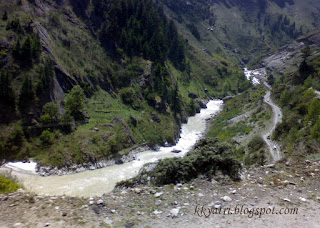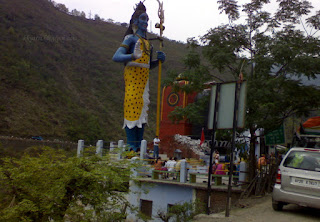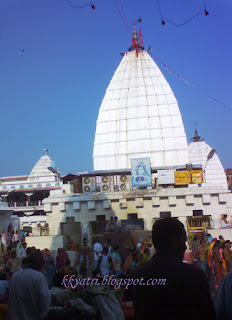(Continued from last blog "Jai Kedarnath")
 |
| Morning view of Chopta, Uttarakhand |
We got up from the bed next morning. It was cold. But the scene outside was fascinating. There was a deep valley full of dense forest on the other side of the road and beyond the valley was range of high mountains on which white snow was spread. On this side of the road was our rest-house which was on the rising slope of another mountain. There was a path going up full of steps some distance away from us. We saw some horses and horse-owners near it. I inquired about it from the hotelwala who in return asked me "Will you go to the Tungnath Mahadev. It is up this path. You may go on foot or on horses". Then he told me that this is one of the "Panch Kedar". It is the place where the tail of the bull (Who was in fact Mahadev) had fallen. Neither we knew about it before coming to Uttarakhand nor had we planned it beforehand. So we said "Namaskaar to Tungnath" from this place only.
 |
Rocks hanging above road ahead us on the way to
Sri Badrinath Dham, Uttarakhand |
This place "Chopta" was a very beautiful and peaceful location on the hills amid forest. Population as a village was not visible to us. There were only a few rest-houses and shops along the road. Even without the religious purpose this place is quite suitable for health point of view. Away from the killing heat of plains, the pure mountain air fills one with energy and freshness.
The street dogs here were of some different breed with more hairs on their bodies to save them from cold in chilling winters. What drew our attention was a wide metal collars around the neck of the dogs that was more loose on the head end than the shoulder end. They said that the hyenas and the leopards from the surrounding jungles come in the night and take away their pets holding them by necks. These collars save the pets.
 |
Meandering road on the hills, way to Badrinath Dham,
Uttarakhand, India |
After we got fresh, we took our breakfast and left this beautiful place in our vehicle. For a long time our vehicle passed through a dense reserved forest in which we did not see people except in a few vehicles moving on the road. After a long journey through forest we were on NH 58. NH58 is alongside the river Alaknanda. About at 11 AM we were in Joshimath where there was a long queue of vehicles on one side of road. It was due to the administration which was clearing the coming vehicles from Badrinath that was large in numbers. When waiting in the vehicle in queue, we saw many boys selling items like asafetida (हींग), Shilajit, etc. and they were asking in every car window. We thought it to be fake, so did not buy. This Joshimath is the place where God Badrinath's idol is kept and worshiped in
 |
A bridge over River Alaknanda near Vishnuprayag
in Uttarakhand, India. |
winters after the doors are closed in Badrinath Dham. About half an hour wait was over and we moved forward slowly gaining the altitude. As we neared, the temperature began to fall but sky was clear and the sun was bright. We saw ice melting on the roadside hills and the cold water coming out beneath them. We were kind of enjoying the journey but a diesel car ahead us was leaving dark fume out of its exhaust pipe. It did not give side for a long time. At least visitors in such places should keep the environment clean.
 |
Alaknanda river coming from Badrinath and the
road alongside that has many bends to go up the hill |
The vehicles reach Badrinathdham directly, no need of on foot journey or horse riding. We saw numerous vehicles parked here. Compared to Kedarnath-dham there is more open space here, so more developed. I asked my family to wait in the vehicle at a place and went asking about our "Panda ji" (priest) Sri Jawaharlal Bhatt. I saw a restaurant and a good market. I had to spend about half an hour time in moving and searching him. I was getting my breathing fast even going up a few steps. Later I thought that it was due to less oxygen in the air at this altitude. Pt Bhatt was a very
 |
Melting ice and thin waterfalls on the way to Badrinathdham,
Uttarakhand, India |
gentle person. He came to our vehicle with me and took us to park it at a place. Then we came with him with our luggage to a "Dharmshala" of a trust that was like a good hotel. It was on the side of the river Alaknanda , the open space and the railing was on the river side. Standing here we could enjoy the fast current of Alaknanda on the rocky bed. On the just opposite side of the river we could see the "Kund" (Pond) of hot water that is also called the "Narad Kund". Devotees were having a bath in it. Bhagwan Badrinath's temple was also visible that was at a level about 20 - 25 ft higher than the Narad Kund . About 100 ft downstream was the steel truss foot bridge through which people were commuting.
 |
A frozen stream on the hills near Badrinath,
Uttarakhand, A small glacier. |
We were hungry so went with "Panda ji" to a restaurant and took our meal. Now we wanted a darshan of Bhagwan Badrinath. "Panda ji" took us to the temple. There was long queue of devotees. We had a darshan from the gate of the temple and got tulsi-dal as "Prasad". The tulsi-dal here were of different variety than we see at our home. Now "Panda ji" told us to take rest for an hour or two, then we shall go for evening "Aarti Darshan" before which we could have a dip in the "Narad Kund". We did so. "Narad Kund" is open from all sides except there is a shade over it. Only gents go into it. A few feet away is another "Kund" for women which is enclosed. Perhaps water sources of both the "Kunds" are linked. I entered in the "Kund" but the water was hotter than I had expected. Standing up to the waist level I was wondering how some other people were
 |
Entrance to Vyas Gufa and the multi-layered rock above
that represents Vyas Pothi (The book of Vyas)
at Mana Village, Badrinath, Uttarakhand |
taking the bath. And a "Sadhu" poured a bucket full of "Kund" water over me from behind. He said "Daro math, himmat kar pani me dubki lo, thik lagega" (Do not fear, have courage and take a dip into the water, it will be ok). One can understand my situation then. Hastily I took three or four dips and came out of it, because do not know why I was not getting accustomed to it and was finding the water unbearably hot. Anyway the hot water made our exertions to away. My family took the dips in women's "Kund" and they said that the water was very hot but not unbearable. They kind of enjoyed it.
 |
The rock named Vyas-Pothi (Book of Vyas) because
the layering resembles the pages of a book and on the right
a board says "Last tea stall of India" at Mana Village,
Badrinath, because beyond this place is China border |
We went to the temple for "Sandhya aarati darshan". They sell three types of tickets for this "Darshan" and in limited numbers. These three are "Swarn aarti, Rajat aarti and Tamra aarti". These ticket holders are only allowed inside main temple and accordingly "Aarti" by their names are performed using golden, silver or copper plate. They are allowed to sit in this order too, Golden at the front and brass at back. Due to the limited numbers these tickets are all sold in the morning itself. Devotees ask their priests in advance to purchase the tickets. Since we had reached here a few hours ago without informing our priest, no tickets were available. But our priest Pt Bhatt ji arranged tickets from another priest whose client did not turn up. These were tickets of "Rajat aarti". We stood in queue.
 |
Fiercely flowing river Saraswati has cut deep gorge in the hill
near Mana Village, Badrinath, Uttarakhand |
This difference in tickets creates arrogance in some people's mind as I saw. A lady ahead of us asked many other ladies about their tickets and replied them that she holds Golden Aarti tickets. We smiled in ourselves. The "Aarti darshan" was really worth visiting. We could see the idols only at a few feet away. The priest conducting this "Aarti" described about the idols and we saw the "Aarti" being performed. It was one of those moments in our life that we would never forget. We returned to our room seeing the temple, river and mountains. Before taking dinner outside we did some marketing.
 |
This big rock across river Saraswati is said to be placed by
Bheem, the Pandava. So it is named as "Bheem-pul" |
In the morning we got up early, took dip in the "Kund" and stood in the queue after about 150 devotees. About after one and half hour we got our chance to enter the temple where there was huge rush. We hardly got the "Darshan" for a few seconds in which the priest took our "Thali" of worship for offering and returned it in a super-fast manner. When out from the main temple we paid our "Namaskar" to other god idols in the courtyard of the temple. Our worship was over. Our Panda ji took us near the ghat of river Alaknanda and told some story from "Puranas" about the place. He told that the two mountains on the both sides of Alaknanda are "Nar-Narayan", avatar of Vishnu who fought for a very long time with "Sahastrabahu" and defeated him. At the
 |
River Saraswati flowing to meet River Alaknanda
at the confluence ahead |
very place where the temple is situated, once God Vishnu started "Tapa" (penance - तपस्या). When the heavy snow fall began His wife Goddess Lakshmi took the form of a tree of zizyphus fruit (बेर का वृक्ष) behind Him and checked the ice falling over Vishnu. So God Vishnu completed his penance without any hindrance. After he opened His eyes and saw the work of Goddess Lakshmi, He thanked Her and said that Now onward this place will be known as Badri-nath because Badri in Sanskrit means zizyphus fruit (बेर का फल). We paid donation to the Panda ji who also asked for a certain amount that he would take when vising at our residence in next January. We agreed but he too like Kedarnath Dham Pandaji got it written in a copy.
 |
We saw this "Pahadi-Jharna" on the return journey from
Badrinath, Uttarakhand |
As I have said earlier that Badrinath Dham is one of the four Dhams of Hindu religion established in four corners of India by "Adi Shankaracharya". He was the great pundit of Vedas and Puranas and he was the person who united the Hindus earlier divided in different sects. These four Dhams he established in four corners of India are for devotees to visit and get acquainted with cultures of different regions. To further strengthen the bond among Hindus he also established the convention of appointing Head priests in each of the Dhams from distant regions. For example the head priest in Badrinath Dhams temple can only be appointed from South India. The selection of priest is also a very difficult process. A person having some special marks (related to God Vishnu) by birth is selected and trained and educated for successor to the present priest. These information were given by our Panda ji.
 |
On the road side we saw this big ice-chunk that had became
like a tunnel due to melting of ice underneath,
Back from Badrinath, Uttarakhand |
Panda ji suggested that before leaving we should visit "Mana" village about one km ahead. "Mana" is the last Indian village before China border. It is a village of "Bhotia" tribe and vehicle plying road ends here. He showed us the "Ganesh Gupha"(Cave of Ganesh) and "Vyas Gupha"(Cave of Vyas). It is said that Maharshi Ved Vyas composed "Puranas" and Ganesh wrote them at this holy place. Ganesh had only one condition that Vyas should speak continuously without a halt on which he agreed. Near the "Vyas Gupha"(Cave of Vyas) there is a big rock different from others. It has numerous thin layers like a bunch of pages in a book. It symbolizes the "Puranas" composed by Maharshi Ved Vyas. They have written on it as "व्यास पोथी" (The book of Vyas)
 |
| Dangerous road at a place back from Badrinath, Uttarakhand |
Near here is a river known as "Saraswati" which is short in length because few hundreds feet downstream it meets "Alaknanda". But it crosses the way to "Satopant" near the origin of "Alaknanda". It is the very way to heavens (Said in Puranas) through which "Pandavas" alongwith Dropadi and a dog went. Dropadi was not finding herself able to cross the river "Saraswati" because it falls with a great speed here and has cut deep gorges in the rocks. So Bhima placed a big rock across the river as a bridge. It is called Bhima-pul (Bridge of Bhima). Now a small temple of Saraswati has been built near here.
 |
At Devprayag is the confluence of River Bhagirathi (Right
with clear water) and River Alaknanda (Left), Ahead they
flow as River Ganga |
The hills around do not have trees, only some herbs and grass grow here. Among these herbs are the variety of "Tulsi" that grows here and its tulsi-dal are used in offerings to Baba Badrinath. Pure air that was slow, freshly scented and cool filled us with new energy. The surroundings are so lovely that one would like to sing the common lines composed by some local Muslim,
पवन मंद सुगंध शीतल हिम मंदिर शोभितम्
निकट गंगा बहती निर्मल श्री बद्रीनाथ विश्वम्भरम्।
(Means that the master of the world God Sri Badrinath is in a temple that is among snow near Ganga and slow, scented and cool breeze blow here)
After seeing all these we took some tea, thanked Panda ji and left Baba Badrinath Dham. We were fortunate that visit to all three Dhams we wished to visit was complete.
 |
A Shiva temple and big Shiva statue at Devprayag,
Uttarakhand |
By the evening we reached Karnprayag, here we decided to take a night halt. Next morning we started our journey back to home. Via Rudraprayag and Srinagar we rached Devprayag. Among high hills two main rivers Bhagirathi and Alaknanda have a confluence here, after this place the river is called Ganga. We stopped our vehicle here and walked up to the "Sangam". Sprinkled some water over us. A Pandit ji came and read some Mantras for Tarpan and we offered water to Pitars. Devprayag is a holy place from ancient times. Tarpan to Pitars has its own importance here.
 |
Manasa Devi temple at the top of hill
at Haridwar, Uttarakhand |
The Kumbh Mela that is arranged now every 12 years at Haridwar
was earlier used to be held here. But due to lack of open space it was shifted to Haridwar. The crystal clear water of Bhagirathi river and the turbid water of Alaknanda create a lovely scene here. A slim variety of fish come in numbers to eat the grains offered in Tarpan. By the noon we reached Haridwar. It was a full moon day and a large number of devotees were having a dip in Ganga here. We took a dip at Har ki poudi and went to worship Manasa devi temple by rope-way. When we left Haridwar the sun was going behind the "Manasa" hill and satisfied to the core we reached back Faridabad by the night, from where we had started our journey a week ago.
 |
| A Shiva Statue in Haridwar, Uttarakhand |
For those planning to go to these dhams should avoid the journey in the rainy season because the danger of landslides increases manifolds and travelers get trapped. I would suggest to plan a journey in the month of May when the doors open for worship, as we did and it remained a hindrance free journey.
 |
Arial view of Ganga at Haridwar
& roapway |
Though People also go these places on package tours by bus and they complete it in a time bound manner, I prefer such tours by taxi or cab. This allows me to have own control over the journey and enjoy more.
By describing the journey of Gangotri, Kedarnath Dham and Badrivishal Dham I have relived the joyful and memorable moments.
===<<<O>>>===





























